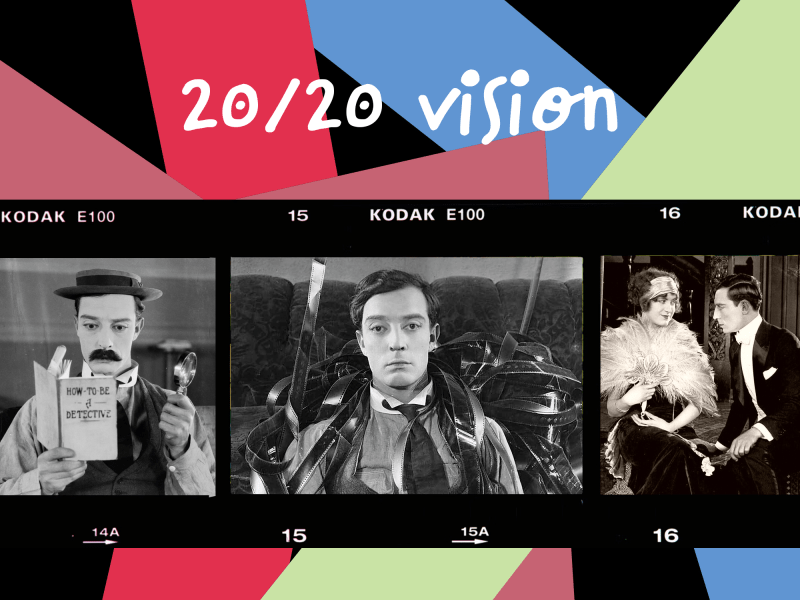The column “20/20 Vision” examines films from the 1920’s through a 2020’s lens. Writer Anthony Martinez Rosales looks at the intricacies of the films from the perspective of culture, medium and quality.
“Sherlock Jr.” (1924)’s 45 minutes of glory prove that films do not need a long runtime to entertain audiences.
This film is a slapstick comedy — a common silent era genre that was popularized by actors such as Charlie Chaplin and Buster Keaton. Keaton later ventured behind the camera, with “Sherlock Jr.” being his third directed film and the shortest of his feature filmography. The story follows an honest yet clueless film projectionist (played by Buster Keaton) who longs to one day become a detective.
When the protagonist is framed for stealing his fiancée’s father’s pocket watch, the fiancée breaks off the engagement. The protagonist later dozes off on the job and dreams of being a great detective like Sherlock, solving the case himself and clearing his name to save the wedding.
Its 45-minute duration is shorter than many contemporary feature films and even TV episodes, but it is a technical achievement in effective storytelling all the same. The short format can be attributed to limiting factors, such as film reels being expensive and the studio wanting to make more money (the shorter the film, the more screenings it can have in a day).
As late as the 70s and 80s, as a result of the rise of VHS tapes, movie studios had an incentive to make movies short enough to fit on the tape. This eventually changed as technology moved from VHS to DVDs and Blu-rays, which diminished the need for short runtimes. Today we are arguably even seeing a trend toward the two- to three-hour “event movies” that draw contemporary audiences into theaters.
Ultimately, this film’s primary achievement is how efficiently it uses its runtime. “Sherlock Jr.” demonstrates that concise storytelling is an effective great way to entertain audiences.
The comedy lands and the simple story manages to keep the audience interested because the movie moves at a constant pace. For example, toward the end of the film, the detective is shown being chased as he tries to rescue his fiancee. While the camerawork picks up some speed, the audience never feels as though they are left behind in the chaos as a result of the seamless transitions from area to area. In slower scenes, the pacing is managed through the use of cut-aways, which frame the action occurring and create a sense of intimacy for the audience.
The film is often credited as an early example of American surrealism, a type of cinema notable for using dreams to portray the current state of the world. When Buster Keaton was asked what inspired him to make a surrealist film, he answered that this was not intentional — he just “wanted it to look like a dream.” Despite this, the film entered the Library of Congress in 1991 as a surrealist work.
I first stumbled across this film when I was in Mexico visiting family and walked into the living room, where my grandfather was sleeping in front of the TV. I sat down to watch it — partly because I was afraid my grandfather would get mad if I switched the channel, but also because the film drew me in. I remember thinking it was actually somewhat funny, and I remember getting frustrated at how absent-minded the protagonist seemed to be.
Taking this anecdote further, it’s interesting that while silent movies were being produced in Mexico, a portion of film content still came from the United States. There really wasn’t much need for Spanish voiceovers — distribution companies could just translate the intertitles of the film for audiences to understand, allowing for the worldwide recognition of silent film stars.
I will admit that “Sherlock Jr.” is not a mind-blowing, twist-and-turns film to the likes of “Interstellar” (2014). In fact, it has a rather simple plot and two-dimensional characters. However, the way the story is told gives contemporary films something to learn.
With filmmakers able to advocate for longer films, they need to learn how to set a consistent pace. Having more time available to directors may seem like a great technological effect, but it can lead more inexperienced directors to get lost in the rhythm of their pieces.
“Avengers: Age Of Ultron” (2015) is a prime example of bad pacing. The movie tries to pack in so many different plot points and characters on top of setting up future conflicts, all within the runtime of 2 hours and 21 minutes. For instance, the film tries to introduce a character and later kills them off in the same movie for an emotional reaction from the audience. Instead, it only makes us feel removed.
While today’s films have to cross the minefield and avoid the traps that a longer runtime creates, “Sherlock Jr.” showcases the significance of snappy and smooth storytelling. It is incredible how Keaton manages to create a connection between the audience and a clueless protagonist that never speaks. Although “Sherlock Jr.” doesn’t have to worry about packing in countless components within one film, it shows that simplicity is key.
Editor’s Note: This article is a review and contains subjective thoughts, opinions and critiques.
